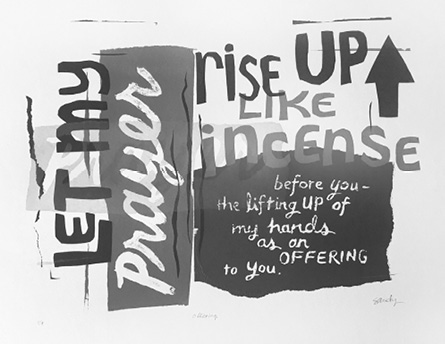Let my prayer rise up

While we are members of First Covenant Church in Seattle, we also attend Saint Mark’s Episcopal Cathedral on the Sundays when our daughter, Elsie, sings in a choir there. Elsie, age 16, has been a chorister at Saint Mark’s since she was five. We have come to appreciate the differences from our Covenant church service — Saint Mark’s is a little more formal and there are many participants in the processionals at the beginning and end of each service.
Over the years, I have been asked to serve as an usher occasionally for the monthly afternoon Evensong service; Elsie also sings in the Evensong choir. And Elsie and I have served as acolytes and banner-bearers for the annual “O Antiphons” service, which marks the beginning of Advent. Both of those services include the presence of incense as part of the liturgy. What a delightful surprise it was recently when the idea of training to be a thurifer (incense-bearer) came up. I was excited but also nervous. This felt like a big deal to me.
Incense is part of the larger purpose of the liturgy, an added sense to be engaged in during the service. In addition to hearing the readings and music, seeing the stained glass windows, altar vestments and banners, tasting the bread and wine at communion, the wafting of incense through the worship space adds scent, as well as the visual of steam/smoke coming from the thurible. It enables all of our senses to be fed, focusing our spiritual selves into worship. On entering the sanctuary, incense is used to purify and prepare the space for worship and for inviting God to be among us.
My thurifer training took place over several Saturdays, being taught one-on-one by a member of Saint Mark’s who was trained in the Catholic church as a young boy; Marc is a pro thurfier and was an excellent teacher. He showed me how to light a small coal and add it to the “thurible” which holds the incense. Once the coal has burned down a bit, the incense can be added. Pure frankincense is used; it’s an organic resin obtained by incising the bark of small Boswellia trees in northeastern Africa. Its scent is mild and pleasing. I practiced holding the thurible, and in a steady manner, getting it to swing forward and back, with minimal arm movement. The focus for the congregation should be on the movement of the thurible while the movement of the thurifer should be minimal so as to be in the background. I practiced processing all around the sanctuary to get comfortable with the motions. The thurifer wears a vestment, too, so it’s important to practice while wearing the long white robe so as to not swing the thurible into the robe.

There are certain very specific movements and rituals for services in which incense is included. The thurifer leads the choir and the officiants into the sanctuary in the opening processional. During the Magnificat, while the choir sings and the congregation stands, the thurifer brings the incense to the presiding priest who then “censes” the four sides of the altar and the cross. This symbolizes our preparation for the coming of Christ and it also symbolizes the ascent of our prayers. Then the priest is censed by the thurifer, bookended by bows, because the priest then becomes an instrument through which God acts in the service. As thurifer, I then “censed” the congregation by standing in the front of the altar, facing the congregation, and swinging the thurible twice to the right, two swings toward the congregants on the left and then two swings of the thurible in the middle—now the congregation is honored as the mystical body of Christ, through which God becomes present. Then I bowed to the congregation. (I’m unaccustomed to bowing, too…another new experience which required practice!)

At the end of the service, I added a few more scoops of incense to the thurible to prepare for the procession out of the sanctuary. While swinging the thurible with little movement from my arm, but a full swing so the steam of the incense is visible, I led the choir and the officiants down the center aisle and back up the side aisle, to exit at the front of the sanctuary. I stepped aside and let the incense waft up as the choristers and officiant processed out.
Incense adds a delightful visual element as well as a sweet fragrance to the air, creating a rather mystical experience. Thinking of prayer rising up like incense is a powerful image to me. The symbolism and the movement and engaging all the senses in this manner expands our worship experience. There is a little mystery in the air.
The words to part of a chorus from “Holden Evening Prayer,” by the Lutheran musician, Marty Haugen, which I learned at Holden Village in 1991, came to my mind that day: “Let my prayer rise up like incense before you, the lifting up of my hands as an offering to you…” I have loved that song for years now but I never could have imagined that I would be offering incense in a worship service, especially having grown up in the Covenant Church which, as far as I know, has never used incense in worship.

'offering,' screenprint, 18 in x 24 in – by Sandy Nelson
Now I’m an official thurifer and I look forward to the next time I serve in that role. It was deeply meaningful to me and also an honor. May our prayers rise up, like incense.
